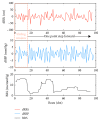Analysis for the Influence of ABR Sensitivity on PTT-Based Cuff-Less Blood Pressure Estimation before and after Exercise
- PMID: 30402213
- PMCID: PMC6196888
- DOI: 10.1155/2018/5396030
Analysis for the Influence of ABR Sensitivity on PTT-Based Cuff-Less Blood Pressure Estimation before and after Exercise
Abstract
An accurate and continuous measurement of blood pressure (BP) is of great importance for the prognosis of some cardiovascular diseases in out-of-hospital settings. Pulse transit time (PTT) is a well-known cardiovascular parameter which is highly correlated with BP and has been widely applied in the estimation of continuous BP. However, due to the complexity of cardiovascular system, the accuracy of PTT-based BP estimation is still unsatisfactory. Recent studies indicate that, for the subjects before and after exercise, PTT can track the high-frequency BP oscillation (HF-BP) well, but is inadequate to follow the low-frequency BP variance (LF-BP). Unfortunately, the cause for this failure of PTT in LF-BP estimation is still unclear. Based on these previous researches, we investigated the cause behind this failure of PTT in LF-BP estimation. The heart rate- (HR-) related arterial baroreflex (ABR) model was introduced to analyze the failure of PTT in LF-BP estimation. Data from 42 healthy volunteers before and after exercise were collected to evaluate the correlation between the ABR sensitivity and the estimation error of PTT-based BP in LF and HF components. In the correlation plot, an obvious difference was observed between the LF and HF groups. The correlation coefficient r for the ABR sensitivity with the estimation error of systolic BP (SBP) and diastolic BP (DBP) in LF was 0.817 ± 0.038 and 0.757 ± 0.069, respectively. However, those correlation coefficient r for the ABR sensitivity with the estimation error of SBP and DBP in HF was only 0.403 ± 0.145 and 0.274 ± 0.154, respectively. These results indicated that there is an ABR-related complex LF autonomic regulation mechanism on BP, PTT, and HR, which influences the effect of PTT in LF-BP estimation.
Figures







Similar articles
-
Continuous Cuffless Blood Pressure Estimation Using Pulse Transit Time and Photoplethysmogram Intensity Ratio.IEEE Trans Biomed Eng. 2016 May;63(5):964-972. doi: 10.1109/TBME.2015.2480679. Epub 2015 Sep 22. IEEE Trans Biomed Eng. 2016. PMID: 26415147
-
Attenuation of systolic blood pressure and pulse transit time hysteresis during exercise and recovery in cardiovascular patients.IEEE Trans Biomed Eng. 2014 Feb;61(2):346-52. doi: 10.1109/TBME.2013.2286998. IEEE Trans Biomed Eng. 2014. PMID: 24158470
-
Characters available in photoplethysmogram for blood pressure estimation: beyond the pulse transit time.Australas Phys Eng Sci Med. 2014 Jun;37(2):367-76. doi: 10.1007/s13246-014-0269-6. Epub 2014 Apr 11. Australas Phys Eng Sci Med. 2014. PMID: 24722801
-
[Blood pressure measurement using pulse transit time].Ned Tijdschr Geneeskd. 2019 Jan 24;163:D3408. Ned Tijdschr Geneeskd. 2019. PMID: 30719885 Review. Dutch.
-
Blood pressure wave propagation-a multisensor setup for cerebral autoregulation studies.Physiol Meas. 2021 Dec 28;42(11). doi: 10.1088/1361-6579/ac3629. Physiol Meas. 2021. PMID: 34731844 Review.
Cited by
-
Recent advances in selective photothermal therapy of tumor.J Nanobiotechnology. 2021 Oct 24;19(1):335. doi: 10.1186/s12951-021-01080-3. J Nanobiotechnology. 2021. PMID: 34689765 Free PMC article. Review.
-
Multimodal Photoplethysmography-Based Approaches for Improved Detection of Hypertension.J Clin Med. 2020 Apr 22;9(4):1203. doi: 10.3390/jcm9041203. J Clin Med. 2020. PMID: 32331360 Free PMC article. Review.
References
-
- Peter L., Noury N., Cerny M. A review of methods for non-invasive and continuous blood pressure monitoring: pulse transit time method is promising? IRBM. 2014;35(5):271–282. doi: 10.1016/j.irbm.2014.07.002. - DOI
-
- Douniama C., Sauter C. U., Couronne R. Blood pressure tracking capabilities of pulse transit times in different arterial segments: a clinical evaluation. Computers in Cardiology. 2009;2009:201–204.
Publication types
MeSH terms
LinkOut - more resources
Full Text Sources
Medical
Research Materials
Miscellaneous

